
views
The COVID-19 pandemic is likely to linger around for a while now even as the vaccination drive gradually picks up pace. This will make physical distancing a mandatory and overarching social practice, increasing our dependence on technology manifold. Our experience of working with young and older adolescent girls, aged between 11 and 18 years, in the states of Haryana and Uttar Pradesh showed that the transition to digital medium has been slow and arduous.
The gender norms deeply entrenched in these societies often restrict and affect the equitable access to technology for women and girls, particularly those from underprivileged backgrounds. They manifest in girls having low digital literacy rates, lack of familiarity with the digital tools, and unequal access to digital or electronic devices.
‘The Mobile Gender Gap Report 2019’ points out that Indian women are 56 per cent less likely to use mobile internet than men, with only 35 per cent of active users in the country being women. Technology is highly gender-cognizant and a growing digital divide is something that India has been grappling with for a long time. For young and adolescent girls, restrictions imposed in the private and public space gets extended to the digital space as well.
Bridging the Digital Divide for Girls
The UNESCO estimates suggest that out of the total population of students enrolled in schools/colleges globally, 89 per cent are currently out of school because of school closures. Of the 1.54 billion children and youth, 743 million are girl students. Even before COVID-19, India had 30 million out-of-school children, of which 40 per cent were adolescent girls. The pandemic is expected to accentuate the existing gap in education, especially for young and adolescent girls.
Major deterrents for girls to access digital technology are:
Social Norms: Social norms control women’s autonomy and aspirations, impacting their access to technology and digital tools. This begins from a very early age, when adolescent girls are controlled in terms of their mobility, access to leisure, use of technology etc. In Uttar Pradesh, for instance, young boys (70 per cent) access the internet regularly as compared to girls (33 per cent) in the age group of 15-19 years (Population Council of India 2019).
Language barrier: Most digital interface is in English, which discourages users. Many girls do not study in English-medium schools as they are more expensive.
‘Patriarchy of pockets’: Patriarchy decides that it is the men of the household who will own digital devices and those will not be a shared family asset or commodity. More than 60 per cent adolescent girls reported that male members of the family have better and easier access to digital devices (Bridging the Digital Divide 2021).
Online violence and abuse: Violence and abuse faced online act as a major deterrent for girls to access digital platforms and applications. Parents often use this as a pretext to control adolescent girls, citing internet as an unhealthy distraction.
Gender Norms at Play
Gender norms, commonly defined as “often unspoken rules that govern the attributes and behaviours that are more powerful and valued and considered acceptable for men, women, and gender minorities”, impact the life-choices, agency and aspirations. Such norms are reproduced and reinforced across different phases of one’s life and through different mediums—individuals, institutions, behaviours, media, etc.
Family, as a primary social institution, operates within the larger patriarchal framework, where restrictions on girl’s mobility and communication get reflected in her limited access to internet and communication platforms. Breakthrough India’s baseline data from Gaya revealed that 76 per cent girls reportedly do household chores as compared to 42 per cent boys. Parents and community members see education as a productive stopgap activity for girls to engage in till the time they are ‘safely married’.
How to Ensure Digital Inclusion
While the economic and health impacts of the COVID-19 pandemic are going to be far-stretched, the social impacts need to be assessed and require immediate action. Loss of livelihood and financial distress at the family level, indefinite school closures, social isolation and distancing practices, lack of social support etc., are going to disproportionately affect the young and older adolescent girls. We need to look at how to address these gaps and challenges, at both systemic and policy level.
Some practical and cost-effective solutions are:
1. Citizens/Community engagement Citizen- or youth-led campaigns to address and recognize the patriarchal social norms and contribute to creating an enabling environment for girls.
2. Community owned and operated resource centres across the country, having computers and printers that would enable continuity of education, especially for girls from poor and underprivileged families.
3. Restrictions and rigidity imposed on adolescent girls by parents and family contributes to their low usage and access of technology. Engagement and conversation spaces with parents and discussion on education for girls as avenues of self-reliance will be helpful in bringing attitudinal shifts.
4. Knowledge- and information-sharing in local language on the usefulness of technology and use of e-gadgets for educational purposes by community groups, citizens groups will break the myths and taboos.
Role of Civil Society Groups
* Working and sensitizing local-level panchayats and frontline workers who have a strong foothold among communities, specifically parents of young girls.
* Strengthening local infrastructure to provide free/subsidized/cheap Wi-Fi access during specific times of the day to facilitate online education for students.
* Local-level solutions that evolve out of community-based needs should be explored instead of “one size fits all” kind of interventions. Last-mile connectivity—in terms of digital reach, affordable access to digital devices, addressing the needs of deprived communities—are crucial to address the learning gap in adolescent girls.
School ecosystem is an important focus for encouraging learning and motivating students, influencing parents and community, and in turn, addressing existing gender biases. School infrastructure should be ramped up, and cater to the provisions of e-learning with proper resources, curriculum in local languages that would encourage learning and aspirations.
As we continue to fight the COVID-19 pandemic, we cannot afford to ignore the need for creating a robust digital infrastructure for young and adolescent girls. Bridging the digital divide will be critical in ensuring that the progress we have collectively made in this space is not lost.
Read all the Latest News, Breaking News and Coronavirus News here.




















Comments
0 comment